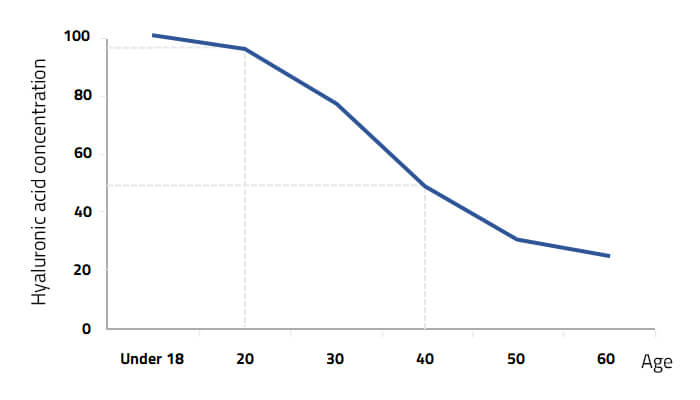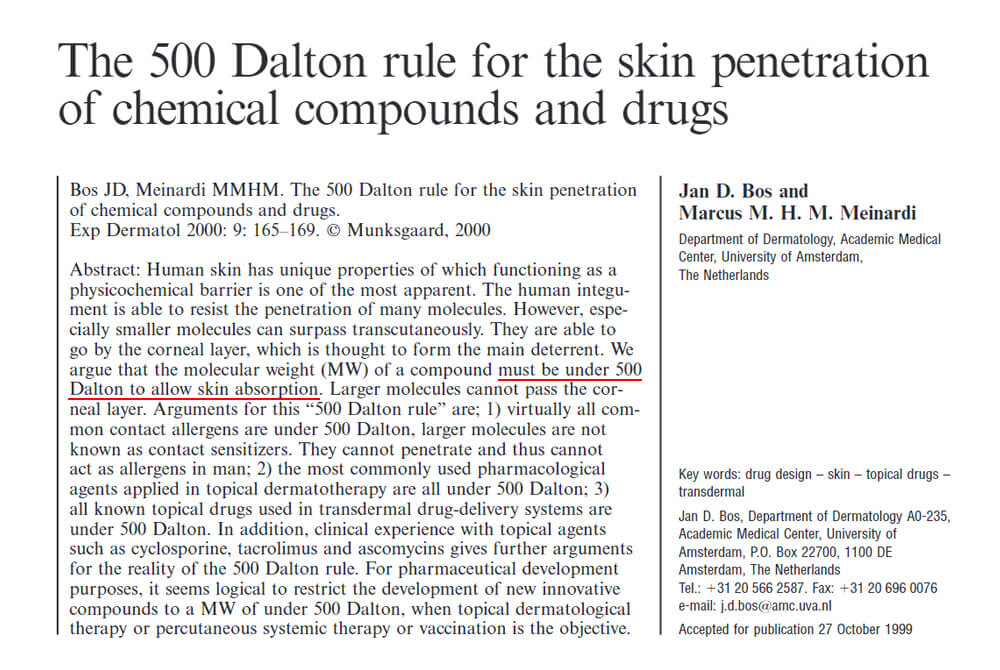INGREDIENT, SKIN CARE
7 things you need to know about Hyaluronic acid for skincare
Is there anyone who doesn’t like looking younger than their actual age? Most people want to look younger.
For this reason, people are interested in anti-aging cosmetics. One of the widely known anti-aging cosmetics ingredients is hyaluronic acid.
Hyaluronic acid is a substance known to the world when Dr. Karl Maier of the University of Columbia published it in 1934 under the title of a paper.
Dr. Karl discovered a transparent substance in the eye of a cow, and it is a mucopolysaccharide with the name “Hyaloid + Uronic acid” because it has no match with the previously discovered substance.

I will explain the contents of hyaluronic acid, which will be helpful if you know about skincare, as shown in the table of contents below.
Table of contents
- Why is hyaluronic acid excellent in capacity in retaining water?
- How does hyaluronic acid work?
- Why is the size of hyaluronic acid important?
- Types of hyaluronic acid used in cosmetics
- How is hyaluronic acid made?
- Hyaluronic acid, how can we use this effectively?
- Hyaluronic acid on the list of ingredients in cosmetics containers
1. Why is hyaluronic acid excellent in capacity in retaining water?
Hyaluronic acid has excellent capacity in retaining water, capable of attracting water that is 1000 times its own weight.
It is distributed in various areas such as the eyes and joints in addition to the skin, and more than 50% of hyaluronic acid in our body is located on the skin.
It is found to be mainly in the dermis among the skin and very small in the epidermis.

The main function of hyaluronic acid is to reduce friction in the joints, allowing them to move smoothly, and to keep the eyes smooth and moist.
In the skin, it is a substance that makes up the dermal layer along with collagen and elastin, and it helps to moisturize the skin by holding moisture and providing elasticity by firmly supporting the skin tissue.
In particular, hyaluronic acid in the dermis holds moisture. Therefore, in the dermis, except for components such as collagen, elastin, and fibroblasts, the rest are clustered like water.
For this reason, hyaluronic acid is in the spotlight as a substance for fillers.
In addition to collagen fibers and elastic fibers, the space between cells in our body is filled with an Extracellular Matrix composed of carbohydrates called GAG(glycosaminoglycan).
It plays a very important role in the skin.
What we need to pay attention to here is GAG. In addition to the Hyaluronic acid we know well, there are six types of GAG: Hyaluronic acid, Chondroitin sulfate, Heparan sulfate, Heparin, Dermatan sulfate, Keratan sulfate.
A common feature of these six GAGs is that they bind well to water molecules because they are electrically negatively charged.
GAGs usually have the ability to bind to more than 1,000 times more water molecules than their own molecular weight, and since these GAGs hold water molecules, they can maintain moisture in the skin. Therefore, GAG components, such as hyaluronic acid, attract moisture in the dermis of the skin keep them well maintained, and make the components in the dermis stay healthy and elastin.

2. How does hyaluronic acid work?
As shown in the image below, when hyaluronic acid holds the frame, it draws moisture into the frame like a sponge.
Hyaluronic acid is said to have the ability to attract surrounding moisture and make it into a “gel” form to prevent evaporation.
That’s why hyaluronic acid may have been nicknamed “Skin’s Moisture Magnet.”
Hyaluronic acid, which is one of the most important components of the dermis, not only decreases with aging but also components such as collagen and elastin decrease along with it, causing wrinkles of our skin.

Hyaluronic acid is produced naturally in our bodies, but its production gradually decreases from the 20s, leading to skin aging.

As you can see from the graph above, especially after the 40s, the body’s hyaluronic acid reserves are halved, resulting in wrinkles because the skin’s elasticity is reduced.
Hyaluronic acid started to be used in cosmetics on the principle that if you supplement the reduced hyaluronic acid, skin elasticity will be maintained.
3. Why is the size of hyaluronic acid important?
You may think that applying a skincare product containing hyaluronic acid to the skin will penetrate the dermis and moisturize the area sufficiently.
Unfortunately, however, due to the molecular structure of hyaluronic acid, it does not work that way.
In December 2001, “The 500 Dalton rule for the skin penetration of chemical compounds and drugs”, a research paper by Professor Jan D.Bos and Marcus Meinardi of the University of Amsterdam Medical School, defined the size of the ingredients that can be absorbed into the skin as under 500 Dalton.

Dalton is the same concept as molecular weight, and the fact that the molecular weight of a component is 500 refers to particulates.
If the molecular weight is under 500 Dalton, it can be easily absorbed through the skin when applied to the skin, and if the size is larger than that size, it becomes difficult to pass through the skin, which is called the “500 Dalton Rule”.
According to the 500 Dalton Rule, when you apply it to your skin, the molecular weight that the skin can absorb is 500 Dalton, but the molecular weight of hyaluronic acid is usually between 3 million and 4 million Dalton, so it cannot be absorbed into your skin.
4. Types of hyaluronic acid used in cosmetics
Hyaluronic acid, as mentioned above, attracts up to 6 L of water per gram, so when you apply hyaluronic acid to the skin, keratinocytes swell by moisture, which increases its penetration, thereby increasing moisturizing ability.
Therefore, the skin looks glossy, moisture is improved, and fine wrinkles are evenly spread out, so the effect appears as if hyaluronic acid penetrates into the dermal layer and replenishes moisture sufficiently.
Since hyaluronic acid penetrates the surface of the keratin layer and affects only the keratin layer, cosmetics companies have recently split the size of hyaluronic acid into small sizes to further improve these.
Hyaluronic acid is divided into “Low Molecular” and “High Molecular” depending on the size of the molecule.
If the molecular size is 5 to 50 kDa, it is classified as a Low Molecular Weight Hyaluronic Acid weight, and if it is 600 kDa or more, it is a High Molecular Weight Hyaluronic Acid.
Hyaluronic acid looks like a long ring in molecular form, and the larger the molecular size, the more difficult it is to be absorbed by the skin.
- Low Molecular Weight Hyaluronic Acid
Low Molecular Weight Hyaluronic Acid refers to the processing of small molecular size while maintaining the inherent properties of hyaluronic acid.
Although it has less water retention than High Molecular Weight Hyaluronic Acid, it is known to be superior to High Molecular Weight Hyaluronic Acid in its ability to penetrate the skin and improve skin texture as well as wrinkle improvement.
- High Molecular Weight Hyaluronic Acid
This is a naturally present hyaluronic acid, an ingredient with a very long molecular ring.
High Molecular Weight Hyaluronic Acid has a very good moisturizing effect because it prevents moisture evaporation by forming a film on the surface of the skin instead of a low absorption rate.
Previous studies have shown that the larger the molecular size of hyaluronic acid, the higher the “collagen” synthesis rate, which helps skin elasticity, while the 50kDa-sized Low Molecular Weight Hyaluronic Acid was effective in inhibiting skin inflammatory reactions.

5. How is hyaluronic acid made?
Hyaluronic acid is contained not only in humans but also in animal tissues, so in the past, it was extracted and used from animal raw materials such as cockscomb.
However, in recent years, hyaluronic acid with molecular weights of various sizes needs to be extracted and raw material prices need to be reduced, so most of them are obtained through the microbial fermentation process.
The extracted hyaluronic acid is made in the form of white powder and is widely used in various products.

6. Hyaluronic acid, how can we use this effectively?
In order to use hyaluronic acid most effectively, we recommend purchasing it in consideration of the aforementioned molecular weight according to your skin condition or preference.
In other words, if you need deep moisturization, use Low Molecular Weight Hyaluronic Acid, and if you want to strengthen your skin barrier, use High Molecular Weight Hyaluronic Acid.
However, since it is not the manufacturer’s duty to mark the molecular weight on a product, it is virtually difficult for you to distinguish the molecular weight only with the ingredients marked on the product containers.
Therefore, when you purchase hyaluronic acid products, we recommend that you purchase products that can check these things in its information marked on the product container if possible.
On the other hand, if you can’t get enough moisture just by using hyaluronic acid, using N-Acetylglucosamine together can be a good way.
It is also good for you to apply it to your skin with a hyaluronic acid-based skincare product, but taking the N-Acetylglucosamine ingredient that promotes hyaluronic acid synthesis in the body can give you a higher moisturizing effect. It is mainly sold in the form of dietary supplements such as vitamins.
In addition, even when you use amino acids or vitamins together, you can get better effects than when you use hyaluronic acid alone.
Hyaluronic acid is a naturally produced component in the human body, so adverse reactions are rare.
However, it can irritate your skin rarely, so if you have very sensitive skin, we recommend testing it before using hyaluronic acid products.
The way to test it is simple. After applying an appropriate amount of the contents of the product you are trying to test on a cotton pad, apply it to a thin skin area inside your arm to examine the reaction. If at this point your skin is not irritating or there are no red spots, then you are safe to use it on your face.
Have you ever heard of MTS(Microneedle Therapy System)?
MTS is a therapy that uses micro-thin needles to make micro-holes on the face and then makes the active ingredients of skincare products such as hyaluronic acid and skin boosters easily penetrate into the skin.
This is a skin treatment method commonly used in skin clinics, and nowadays, roller-type Derma rollers and automatic pen-type tools are also sold to do this at home.
If you apply hyaluronic acid to your face using MTS, you can absorb it more effectively into your skin.

7. Hyaluronic acid on the list of ingredients in cosmetics containers
Even if you look at the ingredient list to see if the hyaluronic acid product you purchased contains hyaluronic acid, you may not find ‘Hyaluronic Acid’ in the ingredients list because the list marked on the cosmetics container’s label usually does not mark “hyaluronic acid” but ” Sodium Hyaluronate.”
The reason is that when 1% hyaluronic acid is added to 99% of water, this 1% is not usually liquid, but powder. Since the powder is usually in the form of sodium, Sodium Hyaluronate, not hyaluronic acid, is listed on the ingredients list.
The rule of marking the ingredients list on the label of the cosmetic container is marked in the front position from the ingredients contained the most in the product.
If you want a product with a lot of hyaluronic acids, you can choose the product with the component in the front position on the ingredients list, on the other hand, if you don’t like a product containing too much of it because it’s sticky, you can choose the product that’s marked in the back position of the list of ingredients.
If your skin is too dry or sensitive, it is helpful to use products containing hyaluronic acid as the main ingredient.


